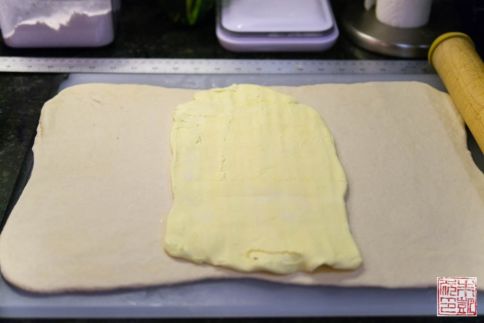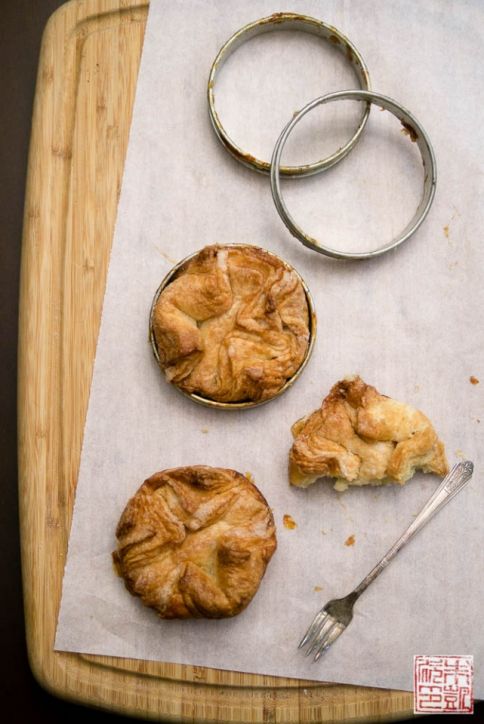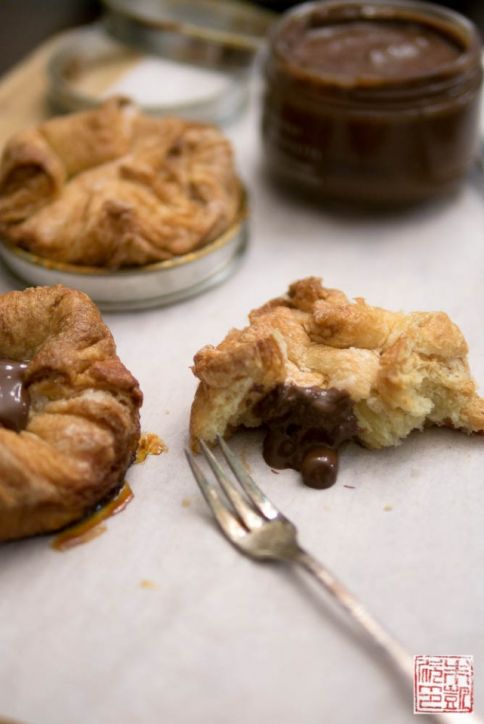Kouign amann: this tongue-twistingly named pastry is also one of the tastiest things I have ever eaten, and seems to inspire such instant devotion wherever it pops up. Essentially an amped-up croissant with lots of extra butter and sugar added in, this pastry is not for those without a sweet tooth, or plenty of stomach space! Although kouign amann comes from France, its name is from Breton, which is a Celtic language. This pastry is a specialty of Brittany, where the Bretons settled after emigrating from Great Britain, way back in the 6th and 7th centuries. The name translates to “butter cake”; although the traditional form of kouign amann is indeed a large round “cake”, most of the ones I see today are individual-sized versions baked in small tart rings.
I’ve made croissants and other pastries before, so objectively I knew that making kouign amann shouldn’t be beyond my abilities. However, the question was whether I could make them well. I’m lucky enough to live in an area where there are not one but two stellar makers of kouign amann. Trying to live up to these formidable examples, and knowing that rather than spending a day in the kitchen, one could just drive up to the city and quickly have a gorgeous specimen in hand, made this project a new level of intimidating.
One of the big keys to success with kouign amann is the butter you use – namely, salted, high-fat butter. In fact, many kouign amann connoisseurs proclaim that proper kouign amann can’t be made without Breton salted butter. Well, for those of use not fortunate enough to dwell in France, the next best option is to use a similar quality butter.
Quick butter facts: most butters produced in the US hover around 80% butterfat. In contrast, butters in France have a minimum of 82%. Of course, the increased fat content makes for a creamier, tastier product in general, but in terms of baking it makes a surprisingly big difference, particularly in laminated pastries. More butterfat means less moisture in the butter, which helps lead to higher, flakier pastries.
For kouign amann, which uses so much butter and sugar, the butter you choose and the care you take in making the dough can spell triumph or disaster. High-fat, flavorful butter will result in a beautifully risen, delectable pastry. Also, one of the common problems encountered in making kouign amann with regular butter is that the additional moisture can cause all the sugar in the dough to liquefy, leading to the collapse of the laminated layers and resulting in a sticky, wet mess. For these reasons, using a high-fat, quality butter is paramount to kouign amann success.
Happily, these days there are several great butter options available outside of France. Look for a butterfat content of 82% or higher, and for a salted version, which is what is traditionally used for kouign amann. While I was at the Winter Fancy Food Show, I got in touch with Kerrygold Butter and they generously sent me some samples of their lovely butter for me to try. What better use than to make some super-rich kouign amann?
As you can see above, the Kerrygold butter is nicely pliable, almost right out of the refrigerator. Just a joy to work with. I had it flattened and shaped into the size I needed in moments, meaning I could return it to the refrigerator before it started melting. If the butter you choose is like a rock out of the fridge and whacking is more an exercise in frustration than supple yielding, try another brand.
Since kouign amann dough is essentially a variant of croissant dough, similar strategies apply to the lamination process, particularly watching the temperature of the dough and butter. It’s critical to keep the butter soft but not melting; if the butter seems to be getting too soft at any time, it’s better to put the package back in the refrigerator and let it chill for a bit rather than try to rush through and end up with soggy, gluey dough.
The chilling time between turns is also important to let the dough relax so it doesn’t become an inflexible, over-glutened mass that is impossible to roll out. The dough will become a little more difficult to roll out after several turns, but it shouldn’t be shrinking like crazy after every pass of the rolling pin. Take your time and give the dough time to chill and relax. Some recipes I read said it should take about 6 hours from when you start the recipe to when you put the kouign amann in the oven, and that was about right for me.
Besides lots of butter, kouign amann also uses a lot of sugar. The traditional recipe has sugar layered into every turn of the dough. However, as I mentioned briefly earlier, one of the dangers is that all that sugar can combine with the moisture in the dough and melt. In order to avoid this, many home recipes have the sugar layered in only at the very end, to minimize sugar contact with the dough. I used this method since it’s fairly humid in my area. Most home refrigerators also have moisture inside, so be careful not to leave the finished dough in there too long. If you want to try the classic method, and layer sugar into each turn, try to make sure the butter is totally enclosed by the dough so that the sugar doesn’t directly touch the butter. The dough will act like a barrier and help keep the sugar dry for longer.
The kouign amann recipe below is taken from the kitchn’s excellent tutorial (see the step-by-step photos if you need more guidance) and from Joanne Chang’s Flour, Too. You can bake this kouign amann in a single 9″ cake pan, but I prefer the mini size, as it allows for more of the fabulous caramelized surface, plus these pastries are so outrageously rich that a single portion should be enough for even the hungriest sweet tooth. Several kouign amann recipes adapted for home bakers suggest making them in a muffin tin instead of pastry rings, I guess under the assumption that most bakers will have a muffin tin in their equipment arsenal. I decided to make them in both so I could compare the differences.
The rings are my trusty 3 1/2″ diameter rings that I use for all my individual tarts. They are about 3/4″ high, enough to allow a nice round base to form and short enough to let the top of the kouign amann bloom out and up, popover-style. I personally prefer the rings as the dough fits in them better (you have to sort of squish the dough into the muffin tin cups) and the pastry seem to keep their shape better. The open bottom also lets the bottoms of the kouign brown and caramelize better. I definitely liked the appearance of ring-formed kouign amann better.
Kouign amann in a muffin tin. This is an entirely acceptable method so if you don’t have any pastry rings go ahead an use this. (Although if you’re a mini-tartlet fan like me, buying a bunch of pastry rings are a very easily-justified purchase). You can see I had to push the dough around to make it fit into the cups, and thus they bake up a little more irregular than in the rings. Also, be aware that you will most likely get butter drips as the dough bakes, so to avoid burning butter on the bottom of your oven, be sure to place a baking sheet beneath the tin to catch any drops. The kouign amann will not caramelize as fully or quickly in the muffin tin as in the rings, so the baking time may be a few minutes longer.
Kouign amann fresh from the oven, golden brown, caramel-crisp on the outside, fluffy-flaky-sugary-gooey on the inside. The delight of a kouign amann is in the contrast of the delicate, crunchy crust and the sweet, buttery interior. It’s like a croissant already slathered with extra butter, and laced with caramel. The salt helps cut through the intense richness and adds the last bit of addictiveness. Another reason I liked the rings better than the tins is that it was easier to unmold the kouign amann. Unlike some other pastries, you have to unmold the kouign amann before they cool down or else the caramelized sugar will harden and make it very difficult to unmold within ruining the kouign amann. I found this especially true for the kouign amann made in the muffin tin, but the rings were pretty easy to slip off, especially when they were well buttered, so I wasn’t as concerned about having stuck pastries. However, both rings and tin produced delicious results. There really wasn’t a big difference in taste wise – even the lopsided, “rustic” kouign amann from the muffin tin were very very tasty. So as long as I wasn’t trying to go up against the professionals looks-wise, my kouign amann were successfully decadent. They were even more decadent after I added a spoonful of Pierre Hermé’s Infiniment Praliné Noisette on top. You probably don’t want to have this kind of breakfast all the time, but when you do, it’s a surely a breakfast to remember.
- 1 1/2 teaspoons active dry yeast
- 1 cup tepid water
- 2 1/2 cups all-purpose flour
- 1 1/4 teaspoons salt
- 2 tablespoons salted butter, melted
- 8 ounces salted butter, cool
- 1 1/2 cups sugar
- Combine yeast and water in bowl of stand mixer fitted with dough hook. Mix until yeast is dissolved.
- Combine flour, salt, and the 2 tablespoons melted butter in a small bowl. Add to yeast and mix on low to combine, about 4-5 minutes. The dough should come together into a small ball around the dough hook. If it is too sticky, add a little more flour, a tablespoon at a time. If it is too dry and won't come together, add a little more water, a tablespoon at a time.
- Cover the dough and let rise for one hour, until it has doubled in size and look puffy. Then transfer the dough to the refrigerator and chill for about 30 minutes while you flatten out the butter block.
- Place the butter on a lightly floured surface and beat flat with a wooden pin. Note: using a quality, high-fat butter will make a big difference in how easy this is. Beat the butter into a roughly 10 inch x 5 inch rectangle. Sprinkle more flour on top as you beat the butter to prevent sticking, and if it seems like the butter is starting to melt, place back in the refrigerator for a few minutes to let it cool down. When you've got your butter block the right size, place back in the refrigerator while you roll out the dough.
- Put the chilled dough on a lightly floured surface. Roll the dough out to roughly 16 inches long by 12 inches tall, with the long side facing you. Take out the butter block from the refrigerator and place in the middle third of the dough, with the short end towards you. Fold the left side of the dough over the butter, and then the right side over, like folding a letter. Carefully roll over the dough with your rolling pin to flatten the layers together.
- Rotate the dough 90 degrees so the long side is closest to you. Roll out the dough to about 20 inches long by 12 inches tall. Sprinkle with flour as necessary to prevent sticking. Fold the left side of the dough over the butter, and then the right side over. This is the first turn.
- At this point if the dough seems to be very soft and warm you can wrap it in plastic wrap and put it back in the refrigerator for about 15 minutes to avoid the butter melting.
- Continue with the second turn: Rotate the dough 90 degrees so the long side is closest to you. Roll out the dough to about 20 inches long by 12 inches tall. Sprinkle with flour as necessary to prevent sticking. Fold the left third of the dough over the middle third, and then the right third over. This is the second turn. Wrap the dough in plastic wrap and chill in refrigerator for 30 minutes.
- Do the third turn: Place the dough down so the long side is closest to you. Roll out the dough to about 20 inches long by 12 inches tall. Sprinkle 3/4 cup of sugar over the dough. Fold the left third of the dough over the middle third, and then the right third over. This is the third turn.
- Do the fourth and final turn: Rotate the dough so the long side is closest to you. Roll out the dough to about 20 inches long by 12 inches tall. Sprinkle the remaining 3/4 cup of sugar over the dough. Fold the left third of the dough over the middle third, and then the right third over. Wrap the dough in plastic and chill for about 30 minutes.
- Thoroughly butter the cups of a 12-cup muffin tin, or (12) 3 1/2" diameter pastry rings. If you are using rings, place them on baking sheet lined with parchment paper.
- Sprinkle your work surface with sugar. Place the dough down with the long side closest to you, and roll out dough to about 24 inches long and 8 inches tall.
- Using a chef's knife or pizza wheel, slice the dough in half lengthwise so you have two 24 inch x 4 inch pieces. Slice each strip into six 4 inch x 4 inch squares.
- Fold the four corners of each square into the middle. Place each piece into a muffin cup (press to make it fit) or into a pastry ring.
- Cover with plastic wrap and let sit out at room temperature for about 30 minutes to 1 hour, until the dough is puffy and risen. Preheat the oven to 400 degrees F while dough is rising.
- When the dough is ready, turn the oven temperature down to 350 degrees. Place dough in and let bake for 30 to 40 minutes until the cakes are golden brown.
- Remove from oven and let cool slightly (but not completely) so you can remove the kouign amann from the cupcake tin without them sticking. The kouign amann are best served the day they are made, while still warm.









Great minds!! I’ve been terrible about keeping up with blogs (my own, included), so it was a complete delight to come here and see your post on kouign amann! It’s almost like we’re back in the DB days 🙂 Love you, Anita!!! xoxo
This thing might spike up my sugar level, but this recipe is very interesting.. Thanks for sharing your recipe.. I will maybe prepare this in the future..or when the kids are around.
I am so happy to discover this pastry! And I csn’t wait to try it. It looks heavy but since it’s originated in France, I am sure it’s good!
Hi Asmae,
It’s best to enjoy this pastry fresh, as all the caramelized sugar is still warm and gooey. Sort of like how croissants are best fresh too! It is definitely a rich indulgence, but it is so good – worth the occasional splurge!
My mouth is watering… They sell these at Four Barrel Coffee (though not with this flavor, I’m dying). Do you know perhaps who makes them?
Hi Carrie,
I believe the ones at Four Barrel are by b. patisserie, which make some of the best kouign amann in town! The actual patisserie is in Pac Heights, you should go check it out!
I think I’ll have to! Hopefully they have a flavor like this one there.
Wow, what a labor of love. I love eating these, but making them seems like a very long process. How long did they take you to make?
Hi Shikha,
It took me about six hours from starting the dough to getting them in the oven, but there’s a bit of down time in between rolling out the dough when it’s chilling in the fridge, so it’s not like you’re actively baking the entire time. If this is the first time you’re making them it might take a little longer. It’s definitely a weekend project like making bread or croissants, but I think it’s worth it!
These are so yummy! I had them when I was in San Francisco not too long ago. As much as I love me a kouign amann, I don’t think I would be able be able to make this… 🙁
Glad you got to try some SF’s best kouign amann! This recipe might look intimidating but I don’t think it’s that hard – in my opinion it’s less difficult than making a layer cake. Or you can start out trying blitz puff pastry (the quick version of puff, do a search on this site) and work your way up to this!
I am in love with these and in love with your talent!
Sharing this on my friday links for sure.
Hi Dawn,
Thanks so much for the kind words and I’m so glad you enjoy my blog! Thanks for the share as well!